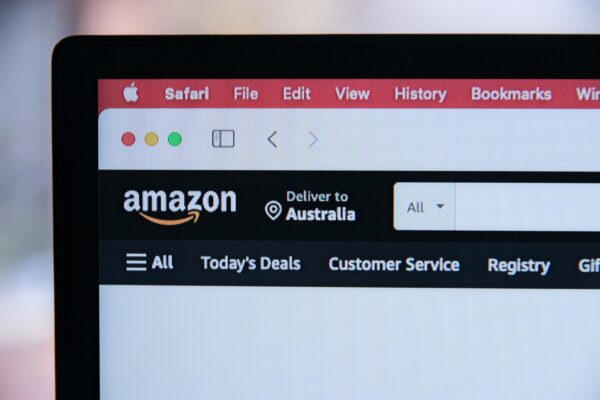Your customers are the key to your FBA business. After all – if you didn’t have any customers you won’t have anyone to buy the carefully selected products that are going to make you a profit. So offering your customers excellent customer service is the best way to keep them happy and turn them into loyal returning customers.

When acting as a third-party seller on Amazon, communicating directly with customers is difficult because they will often see Amazon as the seller and not you. This is where the Amazon Message Center is an excellent tool to help you keep in touch with them about their orders. However, it’s not just a way to chat with your customers, it can also play an important role in improving your seller rating.
In this article we’re going to take a look at what the Amazon Message Center is, how to use it and how it can be used to build relationships with your customers and grow your overall seller rating.
What is the Amazon Message Center?
The Amazon Message Center, also known as the Buyer-Seller Messaging Service, is a way for buyers to connect directly with third-party sellers that are selling products on the Amazon marketplace. If a customer has a query or question about one of your products or an order, they can connect with you directly to ask that question.
Not only that, if you need to communicate directly with one of your customers about their order or product, you can message them directly as well. Under Amazon’s buyer-seller guidelines you can only contact a buyer directly using the Messaging Center in your Amazon Seller Central account for legitimate business reasons.
If you message your customer, it has to be about an order or product and you are not allowed to communicate with them directly for marketing or sales purposes.
For example, you can message your buyer if there’s an issue with shipping their order, but you can’t send them a voucher code to encourage them to order with you again after their order has shipped.
Amazon has very strict guidelines about what you can and can’t do when you message your customers, so we’ve put together a quick summary which outlines them below:
- You can’t send content that isn’t related to their order
- You can’t send content that isn’t related to customer service or support
- You can’t send request that encourage seller feedback
- You can’t send incentives for positive product feedback
- You can’t send promotional vouchers of gift cards
- You can’t send marketing or promotional messaging
- You can’t send email addresses or phone numbers
- You can’t send external links (e.g. to another website)
- You can’t send any other images not related to your brand or company
- You can’t send documents (other than invoices or warranty documents)
You can access the Amazon Message Center by logging into your Amazon Seller Account and then selecting the Message Center from the menu. If you need to message a customer about a specific order directly you simply follow these steps:
- On you Seller Central dashboard, find the “Orders” section
- Select “Manage Orders”
- Locate the specific order then click the “Contact Buyer” option
- You can then choose to message them through seller central or by using their encrypted email address to message them directly through your normal email.
Now we know what the Amazon Message Center is and how to access it, let’s take a look at how it can be used to improve your overall seller rating.
Using the Message Center to improve your seller rating
Your Amazon Seller rating is a metric compiled by Amazon that measures your overall success as a seller. You get a score of between 0 and 100, with a higher score meaning you are a better seller.
Your Amazon Seller Rating shouldn’t be confused with Seller Feedback. Seller Feedback deals with the reviews your customers leave about you or the products they purchase from you, and although your customer reviews do influence your Seller Rating, they form just a small part of it.
Other factors that make up your overall Amazon seller rating are:
Overall feedback – How many customer reviews you have received and whether they are positive or negative.
Cancelled orders – If a customer places an order and cancels you will lose points.
Credit/Debit card chargebacks – If a customer makes a claim to their credit card company saying their card was used fraudulently.
Customer query response times – If a customer makes a query to you directly and you take a long time to respond or don’t respond at all, you will be penalized.
Shipping time – If you advertise 1-2 day shipping, when in reality the order takes a week to arrive, you will lose marks on your seller rating.
Above and beyond service – Amazon actually gives you extra marks if you demonstrate exceptional customer service.
Your returns rate – the more returned products you have, the lower your score will be.
For each order that is placed with you, Amazon will give you a score on the above factors. The score you receive for each order is then added up with the scores for all your other orders over the past 365 days to give you your overall seller rating.
So how is it possible to use the Amazon Buyer-Seller Messaging Service to influence these factors? Obviously, we already mentioned that you can’t directly ask for positive feedback through the Messaging Center but the overall customer service you deliver will help organically generate this for you. Here’s some of our top tips for getting it to work for you.
Tips for using the Messaging Center
Communicate with your customers about late deliveries.
If you’re dispatching your own orders and you know that there’s the possibility of a delay to shipping, use the message center to reach out to them first. Apologise, let them know there’s a delay and give them a realistic timeframe for when it’s likely to arrive.
Although you’ll still get marked down by Amazon for the delay to shipping, by improving the experience they receive you reduce the chance of the customer leaving negative feedback or even worse cancelling the order completely.
Answer queries promptly
If a customer reaches out to you via the message center you’ve technically got 2 days to respond to them. Ideally though you want to do this much sooner. Your goal here is to give your customer as little chance to complain to Amazon or cancel the order as possible. So try and respond as promptly as possible with whatever information they need when they reach out to you.
Be proactive
As we mentioned before in regards to delivery, be proactive when using the message center. Don’t wait for a customer to query a delivery, instead message them first. The same applies to any other problems. For example if you identify an issue with a batch of products, contact customers that placed orders of the same product to make them aware of the problem and what you’re going to do to rectify the issue.
Offer alternatives to returns
Returns can really affect your overall seller rating, so you should try to minimise these wherever possible. If a customer requests a return or refund, reach out to them first to find out what the issue is and see if there’s another way the issue can be resolved. If the item is damaged, you might want to suggest they keep the item and you’ll send them a replacement instead.
Prevent cancellations
If a customer cancels an order, you could try reaching out to them first to find out why they are cancelling. If it’s to do with price, is it possible to give them a discount instead? Obviously you would have to understand if it’s profitable or not to do this first, but an order at a slightly lower margin is still better than no order at all.
Wrapping things up
If you follow tips above, it will mean that you’ll have to spend a bit more time and effort on your customer service than you might usually have; however, it’s definitely worth it and you should seriously consider doing it if you want your Amazon FBA business to succeed.
With many sellers available on Amazon, you should do everything you can to ensure that the service you deliver your customers is as good as it can be.
You’ll notice that if you offer excellent customer service, your customers are more likely to reward you with positive reviews which will help your seller rating overall and a positive seller rating will lead to more sales in the long run.
FAQ’s about the Amazon Message Center
How does the Amazon message center work?
The Amazon Message Center allows buyers and third party sellers to connect directly to discuss issues and queries with specific orders. Customers can contact sellers by visiting their seller page and pressing the “Contact Seller” button. Sellers can contact customers through their Seller Central account.
What is the buyer-seller messaging system on Amazon?
Buyer-seller messaging is another name for the Amazon Message Center and allows 3rd-party sellers and buyers to contact each other to discuss issues and queries with orders.
How long do I have to respond to messages in my Amazon message center?
You have two days to respond to any buyer-seller messages you receive through your Amazon message center, but ideally you should aim to do these much sooner. This will help you build a good relationship with your customers and deliver excellent customer service.
More strategy
-

6 steps to becoming an Amazon seller. No experience needed.
Becoming a successful Amazon seller is easy - the Amazon brand and logo represents…
-

Top tips for success from a new Amazon seller
We've compiled a list of the top tips for new sellers, gathered from a…
-

How to get ungated on Amazon – your guide to Amazon restricted categories
If you’re looking to expand your online arbitrage business, you might find yourself tempted…
-

How to prepare for Amazon Q4 trading
Every year the holiday season seems to come around a little earlier. As an…




